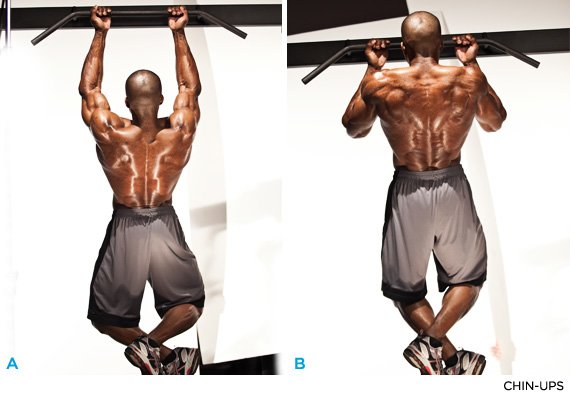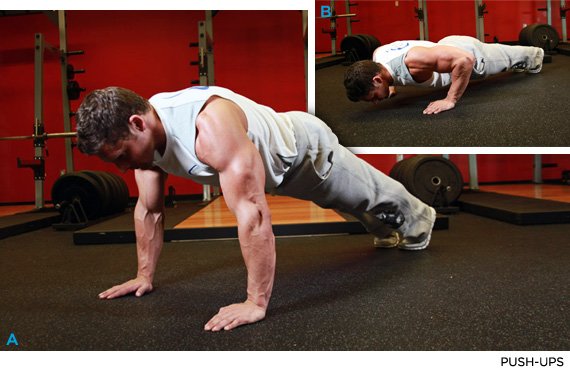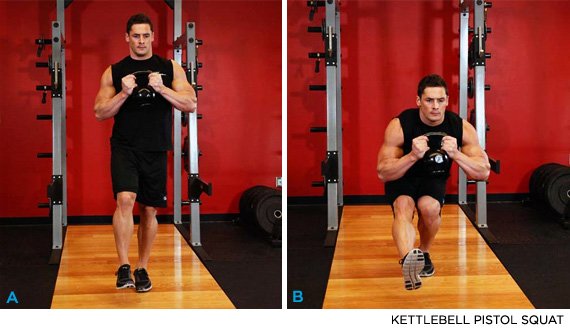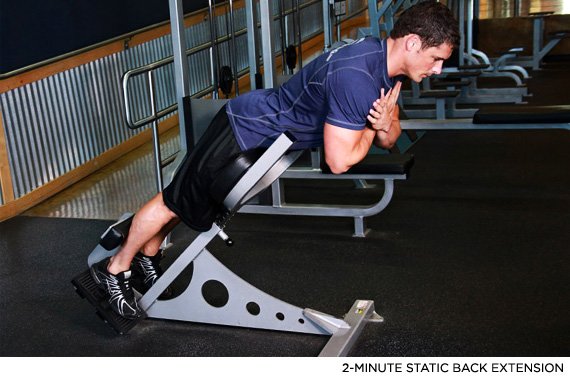






Strength athletes are creatures of habit. They do the same thing day in and day out: go to the gym, lift things, put them down, go to work, go home. Ingest this much of that macro before you do the other thing. Along the way, they get big, they get strong, and sometimes they get bored.
So how do you cure boredom? Set a challenge! Just for something different, forget about adding more weight to the bar. In fact, forget the bar altogether. Set a challenge that involves only your body weight. It will work your upper body, lower body, and core, and increases your muscular endurance along the way.
Endurance? Don't scoff. Life is not always about a quickie, and we're not talking about running a marathon here. If you accomplish these four strength-endurance goals by the end of the year, you can expect a leaner body, added muscle mass, and improved low-back health for your efforts.
The challenge has been set!
20 Chin-Ups Or Pull-Ups
Ask a 250-pound bodybuilder or powerlifter to perform as many chin-ups as possible—and I'm talking about strict, controlled, dead-hang-to-chin-clearing chin-ups—and you'll almost always be able to count the reps on one hand, maybe two if they're lucky, but no more than that. Many guys in the gym who weigh considerably less will knock off 10 or 12 clean reps before hitting the same wall.
Three major factors that determine chin-up success are body weight, body composition, and strength, but the one that trumps them all is the power of the mind. If you believe that you can't perform 20 chin-ups, then you won't! It's a self-fulfilling prophecy. You must believe that you can do it first in order to succeed.
Many people doom themselves before they even grab the bar. So if you constantly max out at 12 reps, your brain expects you to fatigue at that point. It's going to be tough to do another 8 reps, but there is a way. You need to trick your brain.

Here's a tip I learned from Karsten Jensen, a former strength and conditioning coach for the Danish National Elite Sports Institution in Copenhagen, Denmark. Start counting reps at number 10 instead of 1. By the time you hit a count of 20, you have actually performed a manageable 10 reps. Next workout, start the count at 9, the following workout at 8, and so on.
According to Jensen, part of the reason why you fail to achieve 20 reps is because you expect to get tired by the 12th rep, but altering the count and repeatedly creating the experience of achieving 20 reps will help conquer the plateau.
100 Push-Ups
Back in high school and college, you could pop these off like they were nothing. I recall doing 120 push-ups in 1 minute back then—basically 2 reps per second. Fast forward a few years, and all of a sudden, they're not so easy!
Here are four methods to create a situation where you must perform 100 non-stop push-ups, even if you can only do 40 or 50 at present:

- Start with 4 sets of 25 reps with 3-minute rest intervals, and decrease rest each session by 10-15 seconds with the next workout.
- Perform as many sets as it takes to reach 100 total repetitions and record the time. Each session, aim to complete the task in less time, or with fewer sets.
- Use a ladder technique, where you perform 2 reps, then rest as long as it took to complete the rep, probably 2 seconds. Next, do 4 reps and rest for 4 seconds, and continue "up the ladder" in this manner, adding systematically until you can no longer complete the desired number of repetitions. At this point, you either start over again from the bottom or "climb down" the ladder to the beginning.
- Decrease the resistance to achieve 100 consecutive repetitions by using modified push-ups or push-aways, where you push your hands forward using a Valslide, towel, or other sliding accessory rather than pressing up. Increase the resistance slightly each session by raising the height of the knees using a step for modified push-ups, lowering the height of the hands on push-aways, or with the use of a weighted vest on either version.
10 Pistols
Any serious powerlifter should easily be able to squat double their body weight. It stands to reason, then, that they should also be able to squat their body weight on one leg, right? Well, get them to try it and you'll see how that turns out.
The movement is called a "pistol" and it's tougher than it looks to do properly, with a controlled, butt-to-heel technique. Big guys may have all the strength in the world, but their balance, coordination, and flexibility may be another issue! Any strength athlete should aim to be able to knock off 10 reps per leg with their body weight alone, and once that becomes easy, wearing a weighted vest.

If you can't manage 10 pistols, determine what your limiting factor is. Is it flexibility? Then do some stretching, foam rolling and get some body work done. Balance? Then use support initially, like hanging on to the side of a power cage, and eventually wean yourself off one finger at a time. Lacking the strength? Build it up with unilateral movements such as step-ups, split squats, and Bulgarian split squats (i.e., rear foot elevated onto a bench).
2-Minute Static Back Extension
Your core is really strong. You hoist hundreds of pounds—and yet your back always hurts. Then maybe it's not more strength training that you need. You require some endurance training.
Research by Dr. Stuart McGill, a spinal biomechanist and author of the book Ultimate Back Fitness and Performance, determined that endurance is more important for low-back health than strength. A great test for this in the gym is a static back extension, also known as an extensor endurance test or Biering-Sorensen test.

It's simple enough. All you do is perform a typical back extension and hold the top position for as long as you can. Anything less than two minutes is a failure. If you don't succeed initially, keep trying! This is a goal, after all.
If you're looking to get better, just add the movement to the end of every workout. Aim to beat your previous time, even if it's only by a second or two. You'll get up to that 2 minute mark in no time.
John Paul Catanzaro just released his new book The Elite Trainer: Strength Training for the Serious Professional. The book features 55 programs, dozens of training methods and cutting-edge techniques, and more than 100 exercise illustrations. Pick up your copy today at www.TheEliteTrainer.com.
